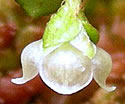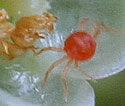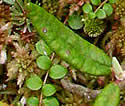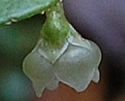Gaultheria hispidula (Creeping Snowberry)
| Also known as: | |
|---|---|
| Genus: | Gaultheria |
| Family: | Ericaceae (Heath) |
| Life cycle: | perennial woody |
| Origin: | native |
| Habitat: | part shade, shade; sphagnum covered rocks and hummocks in cedar/spruce swamps and bogs |
| Bloom season: | May - June |
| Plant height: | 8 to 18 inch creeper |
| Wetland Indicator Status: | GP: FACW MW: FACW NCNE: FACW |
| MN county distribution (click map to enlarge): |  |
| National distribution (click map to enlarge): |  |
Pick an image for a larger view. See the glossary for icon descriptions.
Detailed Information
Flower: 

![[photo of flowers]](/udata/r9ndp23q/pd/gaultheria-hispidula-839-33-t.jpg) Hanging, single flowers on short, hairy stalks in the leaf axils, sporadic along the undersides of the running stems. Flowers are white, bell-like, 1/16 to 1/8 inch across, with 4 dully pointed, broadly oval petal lobes that are slightly flaring. 2 light green bracts embrace the base and a squarish ring of dull orange stamens encircle the single whitish style in the flower center.
Hanging, single flowers on short, hairy stalks in the leaf axils, sporadic along the undersides of the running stems. Flowers are white, bell-like, 1/16 to 1/8 inch across, with 4 dully pointed, broadly oval petal lobes that are slightly flaring. 2 light green bracts embrace the base and a squarish ring of dull orange stamens encircle the single whitish style in the flower center.
Leaves and stems: 

![[photo of leaves]](/udata/r9ndp23q/white/gaultheria-hispidula-creeping-snowberry_0604_142227-t.jpg) Leaves are alternate, simple, evergreen, broadly elliptical to nearly round, ¼ to 1/3 inch long and 1/8 to ¼ inch wide, barely pointed at the tip, the upper surface smooth and dark green, the edges toothless but with widely spaced, bristly hairs. The underside is light green with scattered short, appressed, bristly hairs. Stems are woody with scaly hairs, rooting at the nodes and forming dense, sprawling mats over the mossy hummocks on which they grow.
Leaves are alternate, simple, evergreen, broadly elliptical to nearly round, ¼ to 1/3 inch long and 1/8 to ¼ inch wide, barely pointed at the tip, the upper surface smooth and dark green, the edges toothless but with widely spaced, bristly hairs. The underside is light green with scattered short, appressed, bristly hairs. Stems are woody with scaly hairs, rooting at the nodes and forming dense, sprawling mats over the mossy hummocks on which they grow.
Fruit: 
![[photo of fruit]](/udata/r9ndp23q/pd/gaultheria-hispidula-839-35-t.jpg) Fruit is a white berry about ¼ inch in diameter with scattered brown hairs on the surface.
Fruit is a white berry about ¼ inch in diameter with scattered brown hairs on the surface.
Notes:
Creeping Snowberry is a dwarf shrub, common throughout east central and northeast Minnesota in moist, sphagnum bogs and black spruce forests, typically on top of mossy rocks and hummocks. The dense mats of evergreen leaves are easy to spot and recognize year round but flowering is very early, the sparse flowers not readily noticeable without turning over the branches where they hang from the underside. Fruiting is sparse, the small white berries mildly sweet and wintergreen flavored. Plants spread mostly by asexual reproduction from stems rooting at the nodes as they creep across the mossy substrate. The mat of leaves resembles other members of the Heath family, most notably the cranberries, but Creeping Snowberry is easily distinguished by the bristly hairs on its woody stems and the underside of leaves.
Native Plant Nurseries, Restoration and Landscaping Services ↓
More photos
 a mat of Creeping Snowberry
a mat of Creeping Snowberry more flowers
more flowers a tiny visitor
a tiny visitor Creeping Snowberry habitat, with Labrador Tea
Creeping Snowberry habitat, with Labrador Tea a whole branch from the side
a whole branch from the side
Photos by K. Chayka taken in Lake County. Photos courtesy Peter M. Dziuk taken in Becker, Lake and St. Louis counties.
Comments
Have you seen this plant in Minnesota, or have any other comments about it?
on: 2020-02-28 13:45:42
Small patch seen growing in Theodore Wirth Park. There are many beautiful species of heathers growing in there.
on: 2020-11-26 01:11:26
I also saw this species and just identified it now. I saw it in late September while collecting some seeds from the Drosera there. It has a nice trailing habit and it was growing right on the sphagnum layer. It wouldn't have caught my eye but it looks just like plants in the Marcgravia genus from central and South America. Im going to go back in the spring to see it in flower.






